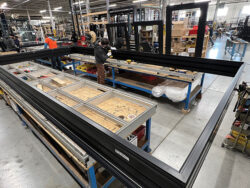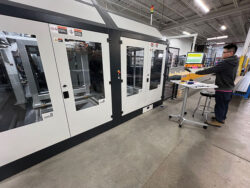
Articles
Fabrication
Bigger and better
An automated CNC processing and cutting centre is driving faster throughput and more precision fabricating at custom entrance specialist, Bigfoot Door.
April 23, 2024 By Carroll Mccormick
 Justin and Nela Zigante established Just Aluminum and Glass in 1980 doing anything and everything in residential fenestration. Today, sons Denis, Dean and Daniel have sharpened the focus to high-end custom aluminum windows, entrances and curtainwall.
Justin and Nela Zigante established Just Aluminum and Glass in 1980 doing anything and everything in residential fenestration. Today, sons Denis, Dean and Daniel have sharpened the focus to high-end custom aluminum windows, entrances and curtainwall. To hone its competitive edge as a niche fabricator of custom, high-performance architectural aluminum windows and doors, Mississauga, Ont.,-based Bigfoot Door purchased a German-made, automated processing and cutting centre – the first of its kind to be set up in Canada.
This January, after a year-and-a-half of intensive planning and preparation, the company flipped on the switches and has been enjoying a rewarding increase in throughput.
Manufactured by Schirmer Maschinen and purchased through Mississauga-based INT Machinery, the Schirmer machine will help Bigfoot maintain its competitive edge and meet the increasing demand for its high-end products.
Bigfoot has a reputation for high-quality work, but it operates in an industry where quality is sometimes sacrificed in the drive for lower prices. Competing on pricing while producing top-notch domestically produced North American-certified window and door systems is an ever-present challenge, explains Daniel Zigante, the president. “Over the past few years, the number of imported windows and doors that fail to meet North American standards and certifications has grown significantly. We have seen a rise in projects using them that have had significant issues. A common concern is the quality of the window and workmanship.”
Daniel’s father, Justin Zigante, launched Just Aluminum & Glass in 1980, which grew to eventually establish Bigfoot Door. A machinist by trade, his early focus was on residential projects: aluminum windows, doors, soffits, and siding installations. Between 1986 and 1994 his three sons, Denis, Dean and Daniel, joined the company. Each brought skills and vision that added depth to the operation and a strong work ethic that Justin and his wife, Nela, who managed the office for 35 years, taught the boys. Denis brought his technical skills and Dean added his architectural and project management skills and introduced CAD technology. When Daniel, the youngest of the three, came on board in 1994, they launched a PVC window manufacturing division called Trillium Window and Door Systems.

Projects like this put the “big” in Bigfoot. The company has made curtainwall assemblies that weight over a tonne.
Over the next 25 years, the operation grew from just 3,000 square feet in 1986 to its current 80,000-square-foot facility. Branching out into commercial projects, their offerings gradually came to include high-profile retail storefront glazing contracts, high-end custom residential installations and specialized aluminum fabrication. Today the company has 60 employees and is seeing “significant” growth opportunities beyond Ontario in Canada and in northern U.S. markets.
In 2012 the company founded Bigfoot Door, upping its game even further as the demand for highly specialized fenestration grew. By 2017, Daniel says, “To meet the increasing demand we decided to shut down PVC production and shift personnel and shop floor space to specialize exclusively in aluminum window and door production. “Increasing size, weight and functionality were limiting what we could offer with PVC frames.”
Higher performance requirements such as triple glazing and new thermal break technology simply outstripped the ability of PVC and fiberglass to handle the added weight in large-format windows and doors, according to Daniel. “We began to research high-performance aluminum window systems and found it better suited for the market and design demands.”
These turning points marked Bigfoot’s transformation into a purely custom manufacturer, with expertise in making huge windows and curtainwall that regularly weigh in at 500 kilograms, and occasionally exceed a metric tonne.
“The systems that we offer are the highest performing and we are capable of supplying massive sizes that PVC or fiberglass just cannot achieve. Our knowledge, experience and in-house manufacturing allow us to be part of very complex projects that very few companies can execute successfully,” Daniel says.
Bigfoot specializes in new residential builds but does take on some major renovation contracts. “We are experiencing growth in replacement window and door projects. We also do commercial projects that require high performance ratings, including Passive House-certified projects,” Daniel says.
“By the mid-2000’s we were getting recognized for our work on custom residential projects. Our expertise, passion and commitment to perfection opened doors to create relationships with the best architects, designers and contractors. As modern architectural design gained in popularity, we saw growth opportunities in a very niche sector,” Daniel adds.
With new opportunities came new challenges. To meet them, the company invested in more specialized and capable fabrication equipment, allowing it to tackle more creative design challenges and attract ever more specialized projects. “Our whole operation is now laser-focused on high-performing fenestration products,” Daniel emphasizes.
The company, which custom fabricates its windows and doors from pre-engineered and pre-designed products, has benefitted from a decade-long partnership with Germany-based Schuco International, a global provider of system solutions for windows, doors, and facades; Bigfoot is North America’s largest fabricator of Schuco products, according to Daniel.
And recently, he says, “We are excited to have begun a partnership with [Belgian-based] Reynaers Aluminium that brings the latest in high-performance window and door technology. These strategic partnerships allow us to offer our customers Canadian-made products that have been tested and certified in North America to meet all North American Fenestration Standards and National Fenestration Rating Council requirements that
architects and builders are demanding.”
Bigfoot’s next step, and it was a big one, was to add production equipment that would increase manufacturing precision and throughput. In mid-2022 Bigfoot purchased a Schirmer machine and set about preparing their facility for its arrival and installation in December 2023.
A year and a half certainly sounds like a generous amount of time to prepare for the addition of another piece of production gear, but this was not your average machine. “The equipment came from Germany in four closed containers and one massive 15-tonne crate. We had to rent a 30-tonne forklift to unload the central cutting station. This was a very intense procedure,” Daniel says.
“You can never prepare too much for something like this. As much time as you have to get everything ready – from purchase, to optimising a new shop layout, to installation – you are also running a business that cannot be disrupted too much,” Daniel explains.

The new Schirmer cutting and processing centre can do all the cutting, milling and drilling on a profile, eliminating a long list of manual tasks.
Preparing for the arrival of the Schirmer machine necessitated tasks such as dismantling racking systems and installing new electrical and air lines. One messy task (among many, no doubt) was cutting out a 20- by 40-foot section of the concrete floor and filling the hole with a 12-inch thick, fibre-reinforced slab capable of supporting the enormous weight of the central cutting station.
Bigfoot flew a team to Germany last September to spend five days at the Schirmer plant in Verl for the commissioning of the fully assembled machine and the first round of training. Then Schirmer chased the machine back to Canada this January, where its technicians gave Bigfoot’s production technicians two weeks of on-site training on the live machine.
“We were training on live jobs, which was great, but scary at the same time. Things went as smooth as you can hope for,” Daniel says. He has nothing but praise for the INT and Schirmer teams for making the training a success.
Maintenance procedures are being fine-tuned and better understood as Bigfoot gains experience on the machine. While Bigfoot equipment operators handle daily maintenance tasks, INT takes care of scheduled maintenance and troubleshooting, and maintain the spares inventory.
While the Schirmer machine presents new fabrication possibilities, its main task is to increase capacity and precision. “It has increased the output of processed bars (machined and cut) and increased the accuracy of all processes,” Daniel explains. “This end-to-end processing – cutting, milling, drilling holes – eliminates a long list of manual tasks, allowing our production teams to focus on assembly. This has had an immediate impact.
“Our whole team did a phenomenal job in preparation, training and execution throughout this whole process, and we are proud of every single effort made. This was truly a team effort.”
Print this page